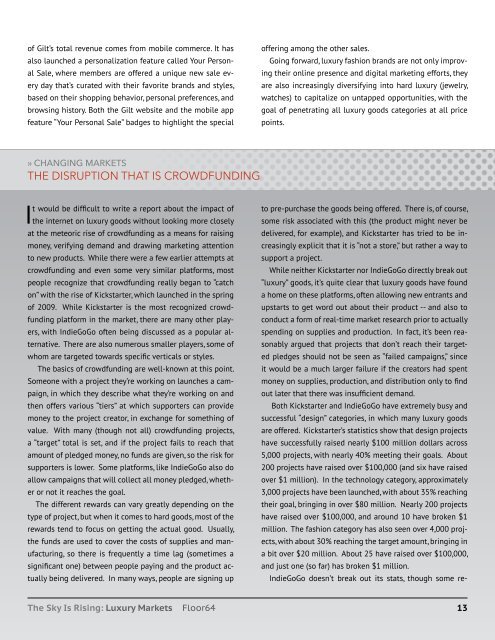Create successful ePaper yourself
Turn your PDF publications into a flip-book with our unique Google optimized e-Paper software.
of Gilt’s total revenue comes from mobile commerce. It hasalso launched a personalization feature called Your PersonalSale, where members are offered a unique new sale everyday that’s curated with their favorite brands and styles,based on their shopping behavior, personal preferences, andbrowsing history. Both the Gilt website and the mobile appfeature “Your Personal Sale” badges to highlight the specialoffering among the other sales.Going forward, luxury fashion brands are not only improvingtheir online presence and digital marketing efforts, theyare also increasingly diversifying into hard luxury (jewelry,watches) to capitalize on untapped opportunities, with thegoal of penetrating all luxury goods categories at all pricepoints.» CHANGING MARKETSTHE DISRUPTION THAT IS CROWDFUNDINGIt would be difficult to write a report about the impact ofthe internet on luxury goods without looking more closelyat the meteoric rise of crowdfunding as a means for raisingmoney, verifying demand and drawing marketing attentionto new products. While there were a few earlier attempts atcrowdfunding and even some very similar platforms, mostpeople recognize that crowdfunding really began to “catchon” with the rise of Kickstarter, which launched in the springof 2009. While Kickstarter is the most recognized crowdfundingplatform in the market, there are many other players,with IndieGoGo often being discussed as a popular alternative.There are also numerous smaller players, some ofwhom are targeted towards specific verticals or styles.The basics of crowdfunding are well-known at this point.Someone with a project they’re working on launches a campaign,in which they describe what they’re working on andthen offers various “tiers” at which supporters can providemoney to the project creator, in exchange for something ofvalue. With many (though not all) crowdfunding projects,a “target” total is set, and if the project fails to reach thatamount of pledged money, no funds are given, so the risk forsupporters is lower. Some platforms, like IndieGoGo also doallow campaigns that will collect all money pledged, whetheror not it reaches the goal.The different rewards can vary greatly depending on thetype of project, but when it comes to hard goods, most of therewards tend to focus on getting the actual good. Usually,the funds are used to cover the costs of supplies and manufacturing,so there is frequently a time lag (sometimes asignificant one) between people paying and the product actuallybeing delivered. In many ways, people are signing upto pre-purchase the goods being offered. There is, of course,some risk associated with this (the product might never bedelivered, for example), and Kickstarter has tried to be increasinglyexplicit that it is “not a store,” but rather a way tosupport a project.While neither Kickstarter nor IndieGoGo directly break out“luxury” goods, it’s quite clear that luxury goods have founda home on these platforms, often allowing new entrants andupstarts to get word out about their product -- and also toconduct a form of real-time market research prior to actuallyspending on supplies and production. In fact, it’s been reasonablyargued that projects that don’t reach their targetedpledges should not be seen as “failed campaigns,” sinceit would be a much larger failure if the creators had spentmoney on supplies, production, and distribution only to findout later that there was insufficient demand.Both Kickstarter and IndieGoGo have extremely busy andsuccessful “design” categories, in which many luxury goodsare offered. Kickstarter’s statistics show that design projectshave successfully raised nearly $100 million dollars across5,000 projects, with nearly 40% meeting their goals. About200 projects have raised over $100,000 (and six have raisedover $1 million). In the technology category, approximately3,000 projects have been launched, with about 35% reachingtheir goal, bringing in over $80 million. Nearly 200 projectshave raised over $100,000, and around 10 have broken $1million. The fashion category has also seen over 4,000 projects,with about 30% reaching the target amount, bringing ina bit over $20 million. About 25 have raised over $100,000,and just one (so far) has broken $1 million.IndieGoGo doesn’t break out its stats, though some re-The <strong>Sky</strong> <strong>Is</strong> <strong>Rising</strong>: <strong>Luxury</strong> MarketsFloor6413


